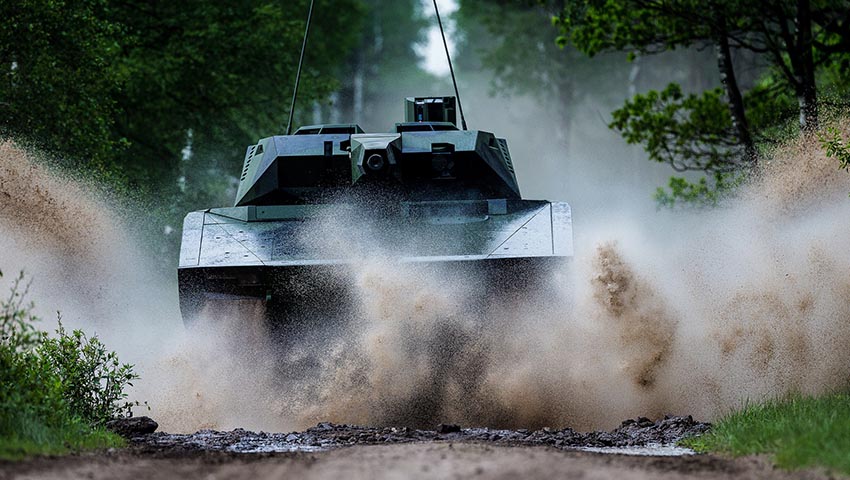After a shock decision in late-2019 to prevent the Rheinmetall/Raytheon Lynx KF-41 IFV from contesting the US Army’s Optionally Manned Fighting Vehicle (OMFV) program to replace the Cold War-era M2 Bradley IFV, the US-German team is back, spelling greater opportunity for industrial collaboration with Australia.
To continue reading the rest of this article, please log in.
Create free account to get unlimited news articles and more!
Raytheon and Rheinmetall joined forces in 2018 to offer Lynx for the Army’s OMFV competition. Lynx is a next-generation, tracked armoured fighting vehicle designed to address the critical challenges of the future battlefield. Lynx provides ample growth capacity to support new technologies over the vehicle’s lifetime, and features lower life cycle costs.
Raytheon and Rheinmetall Defence have established a joint venture to offer the Lynx IFV for the US Army’s OMFV competition. The US-based joint venture is called Raytheon Rheinmetall Land Systems.
Sam Deneke, Raytheon Land Warfare Systems vice president, said in October 2018 at the announcement of the industry collaboration: "Our team will produce and deliver a fighting vehicle to the US Army that protects our troops and gives them an overwhelming advantage on the battlefield. This advanced combat vehicle will be made in America."
Scheduled for fielding in 2026, the OMFV is expected to replace the Bradley fighting vehicle. The new vehicle will be optimised for urban combat and rural terrain. The Army has named the OMFV as a top modernisation priority supported under the service’s Futures Command structure.
Following the announcement that the Lynx would be offered, Ben Hudson, global head of Rheinmetall’s vehicle systems division, said, "Lynx will be built in America by American workers. By choosing Lynx, the Army has an extraordinary opportunity to provide US troops with a fighting vehicle that will enable them to outmatch the threat for decades to come."
However, to the shock of many, particularly in Australia, the US Army disqualified the joint Raytheon and Rheinmetall bid to offer KF-41 Lynx for the Army’s OMFV program.
Lynx is described as a next-generation, tracked armoured fighting vehicle designed to address the critical challenges of the future battlefield. Lynx provides ample growth capacity to support new technologies over the vehicle’s lifetime, and features lower life cycle costs.
It was believed that the biggest issue for the US Army and the joint Raytheon and Rheinmetall team was the proposed delivery date of 1 October – with transport and certification issues within Germany.
The initial disqualification of the Raytheon and Rheinmetall team meant that General Dynamics Land Systems’ offering is the only vehicle remaining in the competition. GDLS has not yet detailed its offering for OMFV but said it was "purpose-built" for the US Army.
However, things appear to have taken a turn as it has recently been revealed that the Rheinmetall-Raytheon team will be presenting a modified variant of the KF-41 Lynx to the US Army following renewed requests for US Army's OMFV program.
Matthew Warnick, the American Rheinmetall Vehicles managing director, told Janes, "[Our proposal] is not going to be the Lynx in its current form, as everybody saw at [the Association of the US Army conference] two years ago. This is going to be revised and evolved based on the final RFP [request for proposal] but it's a great starting point given its next-generation attributes to meet the specific US Army requirements."
As part of a submission to US Congress report of 16 April 2020, the Raytheon/Rheinmetall team had proposed its Lynx vehicle. The vehicle will be able to mount a 50mm cannon and thermal sights and could accommodate both APS and UAVs. Raytheon states that the Lynx can accommodate a nine-soldier infantry squad according to the requirements of the US Army OMFV program.
The US Army has named the OMFV as a top modernisation priority supported under the service’s Futures Command structure.
The Lynx offered to the US Army shared a range of commonalities with the variant offered to the Australian Army as part of its multibillion-dollar LAND 400 Phase 3 program – providing a range of industry collaboration and supply chain opportunities for Australian industry.
Australia's LAND 400 Phase 3 program will replace the M113 armoured personnel carriers, providing the Army with an advanced, world-class IFV capability.
Both options will provide the Australian Army with a range of capabilities, including:
- Hanwha Defense Systems AS21 Redback: The AS21 will include the capability to integrate active protection systems into an evolved turret system. The Redback will be capable of hosting a crew of 11 (three crew, eight troops), a top road speed of 70km/h, cross country speed of 40km/h, an operational range of 500 kilometres, with an armament consisting of a 40mm autocannon and a single 7.62mm coaxial machine gun.
- Rheinmetall Lynx KF-41: The Lynx KF41 will include the capability to support a crew of 12 (three crew, up to nine troops), have a max road speed of 70km/h, a road range of more than 500 kilometres, with an armament consisting of the Lance 2.0 30-35mm autocannon, a 7.62mm coaxial machine gun and a variety of additional close-in weapons systems.
LAND 400 Phase 3 is a $10-$15 billion program, which will recapitalise the Army’s Vietnam-era M113 APC force, with a combination of a tracked IFV and tracked APC.
The risk mitigation activity will commence later this year. Following its completion, Defence will undertake a final detailed evaluation of the shortlisted tenders.
A decision on the preferred tenderer to supply the Phase 3 capability will be presented to government for consideration in 2022.
Stephen Kuper
Steve has an extensive career across government, defence industry and advocacy, having previously worked for cabinet ministers at both Federal and State levels.

 Login
Login








